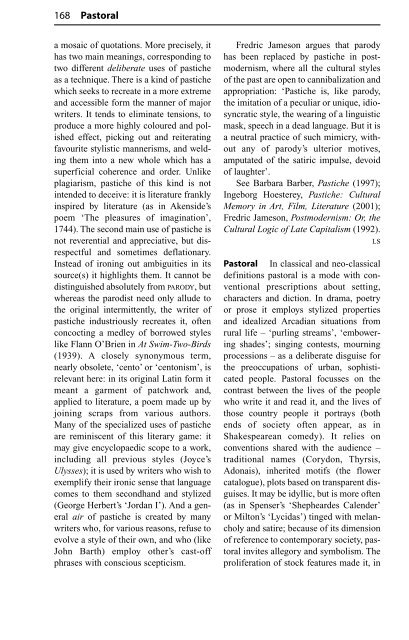The Routledge Dictionary of Literary Terms
The Routledge Dictionary of Literary Terms
The Routledge Dictionary of Literary Terms
You also want an ePaper? Increase the reach of your titles
YUMPU automatically turns print PDFs into web optimized ePapers that Google loves.
168 Pastoral<br />
a mosaic <strong>of</strong> quotations. More precisely, it<br />
has two main meanings, corresponding to<br />
two different deliberate uses <strong>of</strong> pastiche<br />
as a technique. <strong>The</strong>re is a kind <strong>of</strong> pastiche<br />
which seeks to recreate in a more extreme<br />
and accessible form the manner <strong>of</strong> major<br />
writers. It tends to eliminate tensions, to<br />
produce a more highly coloured and polished<br />
effect, picking out and reiterating<br />
favourite stylistic mannerisms, and welding<br />
them into a new whole which has a<br />
superficial coherence and order. Unlike<br />
plagiarism, pastiche <strong>of</strong> this kind is not<br />
intended to deceive: it is literature frankly<br />
inspired by literature (as in Akenside’s<br />
poem ‘<strong>The</strong> pleasures <strong>of</strong> imagination’,<br />
1744). <strong>The</strong> second main use <strong>of</strong> pastiche is<br />
not reverential and appreciative, but disrespectful<br />
and sometimes deflationary.<br />
Instead <strong>of</strong> ironing out ambiguities in its<br />
source(s) it highlights them. It cannot be<br />
distinguished absolutely from PARODY, but<br />
whereas the parodist need only allude to<br />
the original intermittently, the writer <strong>of</strong><br />
pastiche industriously recreates it, <strong>of</strong>ten<br />
concocting a medley <strong>of</strong> borrowed styles<br />
like Flann O’Brien in At Swim-Two-Birds<br />
(1939). A closely synonymous term,<br />
nearly obsolete, ‘cento’ or ‘centonism’, is<br />
relevant here: in its original Latin form it<br />
meant a garment <strong>of</strong> patchwork and,<br />
applied to literature, a poem made up by<br />
joining scraps from various authors.<br />
Many <strong>of</strong> the specialized uses <strong>of</strong> pastiche<br />
are reminiscent <strong>of</strong> this literary game: it<br />
may give encyclopaedic scope to a work,<br />
including all previous styles (Joyce’s<br />
Ulysses); it is used by writers who wish to<br />
exemplify their ironic sense that language<br />
comes to them secondhand and stylized<br />
(George Herbert’s ‘Jordan I’). And a general<br />
air <strong>of</strong> pastiche is created by many<br />
writers who, for various reasons, refuse to<br />
evolve a style <strong>of</strong> their own, and who (like<br />
John Barth) employ other’s cast-<strong>of</strong>f<br />
phrases with conscious scepticism.<br />
Fredric Jameson argues that parody<br />
has been replaced by pastiche in postmodernism,<br />
where all the cultural styles<br />
<strong>of</strong> the past are open to cannibalization and<br />
appropriation: ‘Pastiche is, like parody,<br />
the imitation <strong>of</strong> a peculiar or unique, idiosyncratic<br />
style, the wearing <strong>of</strong> a linguistic<br />
mask, speech in a dead language. But it is<br />
a neutral practice <strong>of</strong> such mimicry, without<br />
any <strong>of</strong> parody’s ulterior motives,<br />
amputated <strong>of</strong> the satiric impulse, devoid<br />
<strong>of</strong> laughter’.<br />
See Barbara Barber, Pastiche (1997);<br />
Ingeborg Hoesterey, Pastiche: Cultural<br />
Memory in Art, Film, Literature (2001);<br />
Fredric Jameson, Postmodernism: Or, the<br />
Cultural Logic <strong>of</strong> Late Capitalism (1992).<br />
LS<br />
Pastoral In classical and neo-classical<br />
definitions pastoral is a mode with conventional<br />
prescriptions about setting,<br />
characters and diction. In drama, poetry<br />
or prose it employs stylized properties<br />
and idealized Arcadian situations from<br />
rural life – ‘purling streams’, ‘embowering<br />
shades’; singing contests, mourning<br />
processions – as a deliberate disguise for<br />
the preoccupations <strong>of</strong> urban, sophisticated<br />
people. Pastoral focusses on the<br />
contrast between the lives <strong>of</strong> the people<br />
who write it and read it, and the lives <strong>of</strong><br />
those country people it portrays (both<br />
ends <strong>of</strong> society <strong>of</strong>ten appear, as in<br />
Shakespearean comedy). It relies on<br />
conventions shared with the audience –<br />
traditional names (Corydon, Thyrsis,<br />
Adonais), inherited motifs (the flower<br />
catalogue), plots based on transparent disguises.<br />
It may be idyllic, but is more <strong>of</strong>ten<br />
(as in Spenser’s ‘Shepheardes Calender’<br />
or Milton’s ‘Lycidas’) tinged with melancholy<br />
and satire; because <strong>of</strong> its dimension<br />
<strong>of</strong> reference to contemporary society, pastoral<br />
invites allegory and symbolism. <strong>The</strong><br />
proliferation <strong>of</strong> stock features made it, in

















